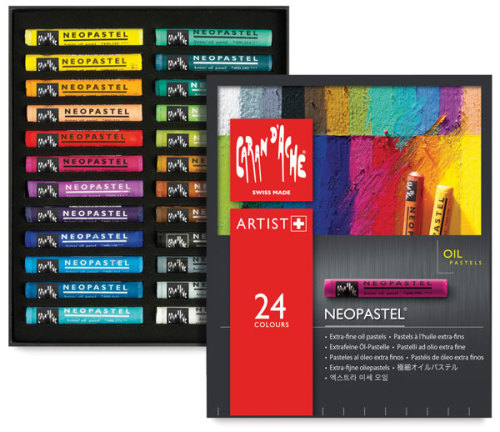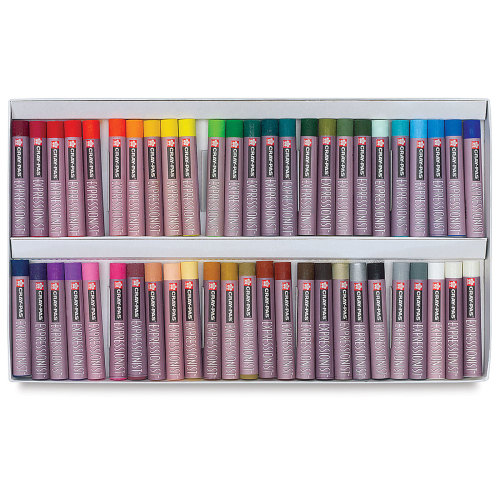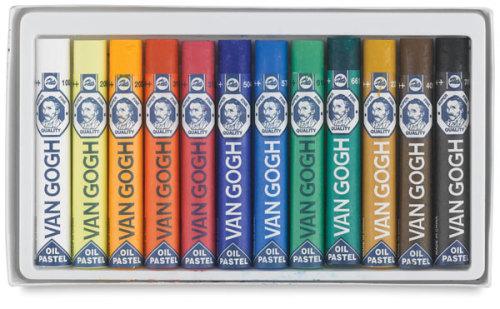The best oil pastels will have a high pigment content and use quality binder. They are a brilliant medium for beginner and professional artists alike. You don’t need too many different supplies to get started with oil pastels.
Find different brands of oil pastels to suit your needs, budget and drawing style in this review.
Disclaimer: Fine Art Tutorials is a reader supported site. When you make purchases through links on this site, we may earn a small commission at no extra cost to you.
Sennelier oil pastels

Attributes: creamy consistency, fairly soft, highly pigmented, professional quality, more expensive than other brands
Rating: 5/5
Sennelier oil pastels are perhaps the most well known brand of oil pastel and they were also the first to be manufactured. They were first made in 1949 by Henri Sennelier who was asked by a friend of Pablo Picasso’s to make a wax based colour stick, as Picasso was looking for a medium that could be used on a variety of surfaces without fading or cracking.
The Sennelier oil pastels remain to be one of the best oil pastels available to buy. They have a unique set of working properties, a large colour range and have a high pigment content. The colours appear bright and colourful on paper and do not fade over time, due to the excellent lightfastness of the pigments used.
These pastels have a creamy consistency that is slightly harder and less powdery than ‘soft pastels’. Incredible painterly effects can be achieved. This means that you can be expressive with mark making as colour glides across the paper and blends with ease.
The colour mixing and blending capacity of these pastels is brilliant. Sennelier uses mostly single pigments in their pastels, which gives clean mixes. There is a brilliant range of sets provided by Sennelier, whether you are a portrait, seascape, landscape or still life artist, there will be a set for you.
Sennelier makes a mix of transparent, semi transparent and opaque colours. You can use the transparent colours like turquoise blue and ultramarine to glaze over sections.
For artists who love working on a bigger scale, Sennlier manufactures a giant range of pastels. The smaller pastels have a rounded, sharpened point, which makes them suitable for creating thinner lines and detailed marks.
At the time of writing this review, each Sennelier pastel costs $3.89+. So they are one of the priciest on the list, but also the best quality. If you’re an artist who values quality and doesn’t mind paying for it, these are the best choice.
Caran d’Ache Neopastels

Attributes: smooth, blendable, highly pigmented, professional quality, cheaper than Sennelier
Rating: 5/5
Swiss made Caran d’Ache Neopastels come in a range of 95 individual pastels and they also have a range of curated sets to suit various applications.
The texture could be described as rich and velvety, but they feel wonderfully soft to use. Another great thing about these pastels is they are virtually dust free. Compared to soft pastels which can generate quite a bit of dust over a session, these pastels are much cleaner.
These pastels are wax based and therefore are not water soluble. Optionally, you can paint a tiny amount of solvent to thin the pastel on the surface. You can get creative with how you use solvent with pastels—brush a small amount on the end of the pastel to create intense highly saturated marks on the paper. Or use them dry to create subtle transitions in tone and value.
These pastels are cheaper than the Sennelier oil pastels and start at around $2.70 per pastel. They differ from the Sennelier pastels in that they have flat ends, meaning that you can make thin or broad marks.
They are harder in texture than soft pastels, so they don’t smear or blend as easily, but this can be beneficial for those who prefer the hard edges and details the medium soft pastels provide.
The pastels themselves are smaller compared to other artists’ brands of pastels and some artists mention that the wrappers can be difficult to peel off without damaging the pastel.
Holbein Artists’ Oil Pastels

Attributes: professional quality, most expensive, great colour range of tones, 225 colours
Rating: 5/5
Holbein, a Japanese based company, manufactures professional grade artists’ oil pastels that use the Munsell colour system as a standard to create the hues, values and chroma of their colours. Most of their colours have a permanent lightfast rating.
The oil pastels are highly pigmented and the consistency is smooth, yielding even looking results on the surface. These pastels are slightly drier in texture compared to Sennlier and Caran d’Ache which feel more greasy, but they are incredibly soft and feel luxurious to use. The Holbein pastels don’t have the same sticky feel that other brands of pastels have.
Square in shape, the pastels can be used to create broad marks when held flat, or the corners and sides can be used for sharp lines and details.
Per item, these oil pastels are the most expensive, which can get pricey when you factor in shipping fees. Nonetheless, they are a quality product that will be worth the price tag for artists looking to create vibrant, archival quality pastel drawings.
These pastels have excellent surface stability and stick well to the substrate, compared to soft pastels which can have a tendency to crumble when on the surface. For this reason, using a fixative isn’t completely necessary with Holbein pastels. A reason why you may want to avoid using fixative is because it dulls colours. So by using a substrate like Pastelmat which provides enough tooth for the pastel to adhere, and by working with a pastel like Holbein, you can avoid using fixatives. Instead, mount the drawing behind museum glass once finished to preserve it.
Because of the brilliant surface stability, these pastels can be used on a variety of surfaces, like wood, panel, paper and canvas. They can also be used over dry oil or acrylic paint.
Sakura Cray-Pas Expressionist Oil Pastels

Buy Sakura Cray-Pas Expressionist oil pastels
Attributes: cheap, smaller colour range, non-toxic, vibrant colours, blend well, great for beginners, student grade, firm
Rating: 3.75/5
These pastels are great value, feel smooth to use on the paper and have brilliant blending characteristics. The pastels start at $.79 per pastel, which is incredible value for what they are.
The pastels have good lightfast ratings, but are not as permeable as other brands such as Holbein, Sennelier or Caran d’Ache. For this reason, if you were choosing pastels for professional work, I would go with one of the top three brands on this list.
Sakura Cray-Pas oil Expressional pastels would be a great choice for beginners or students. Equally, a seasoned artist would enjoy using them due to the vibrant colours and the ability to make bold strokes.
The colour range is good, but smaller than other oil pastel brands. However, Sakura makes a balanced palette, suitable for a range of applications and drawing various subjects.
The texture of the pastels is firmer than other brands, however, they still feel smooth to use. These pastels are more crumbly than the professional grade pastels, which can be a bug bear for some artists. For the price these pastels are a brilliant option for those who want to try the pastel medium.
Royal Talens Van Gogh oil pastels

Attributes: Firm but waxy, great colour range and sets, artist quality pigments, reasonable price, student grade
Rating: 3/5
These pastels are on the higher end of the student grade materials spectrum. They are more expensive than other student grade ranges, however.
The colours are available to buy individually as well as in sets. Per pastel, they cost $2.25, almost the price of the lower end professional grade ranges.
The pastels are smooth, and firm, a similar texture to the Sakura Cray-Pas pastels. They also have similar lightfast ratings of good to fair. However, they feel waxier than other brands, due to the combination of binder agent and additives. This gives them a less luxurious feel and makes techniques such as blending feel more difficult.
They can be used on a variety of surfaces, including paper, board, panel, even earthenware. The lightfastness of colours is good, but not as high as other professional grade pastels such as Sennelier.
Royal Talens manufacture a great range of earth tones and warm grey colours, as well as tint colours of traditional pigments such as yellow ochre. The same pigments are used in this brand compared to higher end ranges, but the pigment content seems to be lower than higher end ranges. They are a decent size and easy to use, overall a good choice for a beginner or intermediate level artist.
Derwent Academy Oil Pastels

Buy Derwent Academy oil pastels
Attributes: vibrant, student grade, affordable, creamy texture, dust free
Rating: 3/5
These are a great affordable choice for students, hobbyists and aspiring artists. They have a unique, soft, creamy texture. This makes them ideal for practising techniques like blending, smudging and layering.
The best oil pastels for beginners
The best oil pastels for beginners are the Sakura Cray-Pas Expressionist pastels. They’re cheapest to buy and have a firm yet smooth texture which makes them easy to work with for those who don’t have much experience with the medium. Added to this, they are non-toxic, so they don’t manufacture colours with potentially harmful pigments. This means that they would be suitable for use in a classroom setting or with students.
What are the best oil pastels for professional artists?
The best oil pastels for professional artists depends on personal preference. Sennelier, Caran d’Ache and Holbein are all good contenders that create archival quality, highly pigmented materials. Holbein has an excellent colour range but the pastels are expensive to buy, Sennelier pastels are creamy, smooth, bright and a joy to work with.
The best sets of oil pastels
Sennelier makes some beautifully presented and curated sets for professional artists. Their set of 120 is encased in a wooden box, which includes their complete range. For portrait artists, they make a set of skin tones, earth colours, warm greys and red tones for lips. Their landscape set includes shades of green, sky blues, yellow and various earth pigments to make for a wonderful nature inspired palette.
Student grade vs artist grade oil pastels
Student grade oil pastels tend to be made with a lower concentration of pigment, a lower quality binder and include fillers and additives like clay that can change the working properties. Professional quality pastels will feel smoother and make more consistent marks, they will also appear more vibrant on the paper. The student quality brands can vary in handling properties, feel less consistent and more unpredictable to use. Colours will appear duller on the paper and when mixed with other colours may appear muddy.
Why are oil pastels a great option for beginners?
Oil pastels are a great medium for beginners to get started with because very few supplies are required to get started. All you really need is paper, a set of pastels and you’re ready to go. There are optional extra tools and supplies you can get that can improve your drawing process, but they’re not necessary.
What puts a lot of beginner artists off learning oil painting, or acrylic painting, is the need to get all the additional supplies, like expensive easels, palettes and brushes. With oil pastels, you can buy minimal supplies, pack them away small, and set them up on any table or desk when you feel like drawing. The benefit is a faster set up and packing away time, which means more time practising drawing!
Added to the lower cost, fewer supplies, ease of set up, the pastels can provide you with professional quality artworks and beautifully vibrant results (if you get the artist grade supplies).
How are oil pastels different from soft pastels?
Soft pastels are made from different ingredients than oil pastels. Oil pastels are made from pigment, non drying oil and wax, whereas soft pastels are made from pigment, chalk and gum arabic. Then hard pastels are made from pigment and clay.
Soft pastels feel incredibly soft, but also slightly more powdery and less slick and greasy than oil pastels. Oil pastels tend to create less dust and mess than soft pastels and don’t break as easily.
Check out our soft pastel brand review for more information, or if you want to learn more about the differences, read our oil pastels vs soft pastels guide.
What are oil pastels made from?
Oil pastels are made from pigment, non drying oil and wax binder. For example, Sennelier oil pastels are made from pure, quality pigments, an inert binding medium that does not oxidise and mineral wax.
Buying pastels that use a quality binder is important, as it means that colour will be released smoothly and consistently onto the paper.
What are the working properties of oil pastels?
Oil pastels are non-siccative, which means that they never fully dry. This means that pastels require fixing between layers, to create separate colours and hard edges unless using a surface like Pastelmat. Bear in mind that fixing layers can cause colours to look dull. If you want to avoid using a fixative, mount and frame the pastel drawing behind museum glass and take care not to smudge it if transporting.
Pastels are soft, so they can be blended and worked into one another to create colour mixes. If you want to create a thin layer, you could use a little solvent, like turpentine to make the colour more transparent and runny.
Oil pastels will feel oily and slick and they dry to feel sticky unless and final fixative is applied. They feel wonderful to draw with, as they release much more colour than the harder oil coloured pencils.
How do you draw with oil pastels?
Pastels can be layered on the surface and blended to make realistic colour gradations. Many pastels artists gravitate towards drawing realistically, but many also lean towards drawing expressively.
The best way to work with oil pastels is light to dark. However, light colours of professional grade pastels should provide a reasonable coverage over darker colours. Sketch lightly at first to establish composition, then press harder to make more intense and vibrant marks. With a light touch, pastels can make subtle colour transitions. By applying pressure, enough oil and wax binder will be released to appear like paint.
The interesting quality of pastels is that you use them with a drawing motion, but they can take on the appearance of paint. This allows artists to be expressive with their mark making, creating artworks that exude feelings of movement.
Studio safety advice for oil pastel work
Because pastels are hand held, I would recommend wearing gloves to avoid getting messy. Plus, some pastels have toxic pigments such as cadmiums and cobalts in them, which can be potentially harmful over time if you get a lot on your hands or accidentally ingest residue that, for example, touches food. It’s best, especially if you use your fingers to blend colours, to wear gloves to avoid these problems.
What other supplies do you need for pastel drawing?
It’s just as important to choose a quality substrate as it is to choose quality pastels, the longevity of the pastel drawing will depend on it. Go for an archival, thick, acid-free paper with ‘tooth’ such as Pastelmat. The thickness and texture of the paper will allow you to create more colour layers, without having to use as much fixative. This will result in more clear and vibrant looking artwork. If you want to work on a thicker surface like a wooden board, Pastelbord is a fantastic option.
Further Reading
The Virtual Instructor gives an insight into how to draw with oil pastels.
This beginner’s guide to oil pastels by Tim Fischer shows artists how to use the medium, both on their own and in conjunction with other artists’ materials like acrylic inks to create wonderful archival quality works.
If you’ve found anything on this site especially useful, you can make a donation to me through PayPal. I take a lot of time to research and write each topic, making sure each tutorial is as detailed as possible and I make all my content freely available. Any small donation (even the price of a cup of coffee!) can help me to cover the running costs of the site. Any help from my readers is much appreciated :).
Follow the link in the button below to support this site.


Sakura Cray-Pas is by far the best oil pastels I have worked with. I will keep buying more. I recommend these for any1 trying art craypas.
This was my first time using oil pastels and I have Caran Dache oil crayon. They both have an amazing colour payoff, but these are much easier to blend with your fingers. You can create amazing textures with them and use scraping tools to see underneath colours.
I bought some Sennelier oil pastels and wow they are amazing
Expensive but amazing